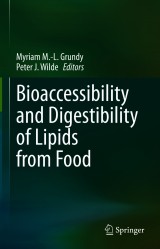Details

Bioaccessibility and Digestibility of Lipids from Food
|
171,19 € |
|
| Verlag: | Springer |
| Format: | |
| Veröffentl.: | 19.01.2021 |
| ISBN/EAN: | 9783030569099 |
| Sprache: | englisch |
Dieses eBook enthält ein Wasserzeichen.
Beschreibungen
<div>The structure of a food influences the way it is transformed during processing and digestion. This in turn has an impact on nutrient bioaccessibility (release) and digestibility, and subsequently on the physiological response and health of the individual who consumes that food. </div><div><br></div><div>Although evidence exists on the health benefits associated with the inclusion of certain lipid-rich foods (e.g. nuts, dairy products and fish) in the diet, the mechanisms that explain the physiological effects and the long-term benefits are not well understood. Lipids in themselves have many beneficial health effects: they are a source of energy and essential fatty acids, they are structural components of cell membranes, they are required to solubilise fat soluble compounds, and they serve as precursors of hormones. In addition, the overall structure of the food containing the lipids plays a crucial role in determining health benefits, notably by influencing lipid bioaccessibility and digestibility. </div><div><br></div><div><i>Bioaccessibility and digestibility of lipids from food</i> uniquely focuses on the physico-chemical properties of lipids and lipid rich food, as well as the subsequent effects on human health. Chapters from experts in food digestion examine food structure at both the macro- and micro- levels, covering lipids from plant and animal food products. The editors have developed the book for dietitians, nutritionists, and food scientists. Clinicians and other health professionals, educators in nutrition, and others working in the food industry will also find the material relevant.</div>
<p>Part 1- Digestion of lipids.- 1 Enzymes involved in lipid digestion.- 2 Colloidal events that may affect lipid bioaccessibility and digestibility.- 3 In vivo and in vitro evaluation of lipid digestion.- Part 2- Lipid metabolism.- 4 Oral processing of lipids.- 5 Physiological aspects of lipid digestion.- 6 Lipid and cardiovascular disease risks.- Part 3-Food structure.- 7 Plant food and dietary fibres.- 8 Diary products and lipid digestion.- 9 Interaction with macronutrients.- Part 4 Other forms of lipids.- 10 Lipid digestion and bioaccessibility of lipid soluble molecules.- 11 Sterols digestion.</p>
Dr Grundy is a Research Scientist at INRAE within Physiology, Environment and Genetics for the Animals and Livestock Systems (PEGASE) research unit. She has a background in Biochemistry and Nutrition, and has a PhD from King’s College London, during which she investigated the role of cell wall in modulating lipid bioaccessibility in almonds. Her research interest focusses on the physiochemical mechanisms that determine the bioaccessibility and digestibility of nutrients from complex food matrices, in particular she studies the role played by dietary fibres.Prof Pete Wilde heads the food structure and digestion research at the Quadram Institute Bioscience, Norwich UK. He has been researching the physical chemistry of food structures for more than 30 years. His current research focuses on the physico-chemical mechanisms by which food structures control digestion and nutrient release. He has published over 150 papers. He is an Honorary Professor in the School of Pharmacy at theUniversity of East Anglia and a Visiting Professor at the School of Food and Biotechnology at Zhejiang Gongshang University, China.<p></p>
The structure of a food influences the way it is transformed during processing and digestion. This in turn has an impact on nutrient bioaccessibility (release) and digestibility, and subsequently on the physiological response and health of the individual who consumes that food. <div><br></div><div>Although evidence exists on the health benefits associated with the inclusion of certain lipid-rich foods (e.g. nuts, dairy products and fish) in the diet, the mechanisms that explain the physiological effects and the long-term benefits are not well understood. Lipids in themselves have many beneficial health effects: they are a source of energy and essential fatty acids, they are structural components of cell membranes, they are required to solubilise fat soluble compounds, and they serve as precursors of hormones. In addition, the overall structure of the food containing the lipids plays a crucial role in determining health benefits, notably by influencing lipid bioaccessibility and digestibility. </div><div><br></div><div><i>Bioaccessibility and digestibility of lipids from food</i> uniquely focuses on the physico-chemical properties of lipids and lipid rich food, as well as the subsequent effects on human health. Chapters from experts in food digestion examine food structure at both the macro- and micro- levels, covering lipids from plant and animal food products. The editors have developed the book for dietitians, nutritionists, and food scientists. Clinicians and other health professionals, educators in nutrition, and others working in the food industry will also find the material relevant.</div>
Discusses food structure at both the macro- and micro-levels Covers lipids from plant and animal food products Examines the relationship between the physico-chemical properties of lipids and subsequent effects on human health
Diese Produkte könnten Sie auch interessieren:

Tropical and Parasitic Infections in the Intensive Care Unit

von: Charles Feldman, George A. Sarosi

149,79 €















